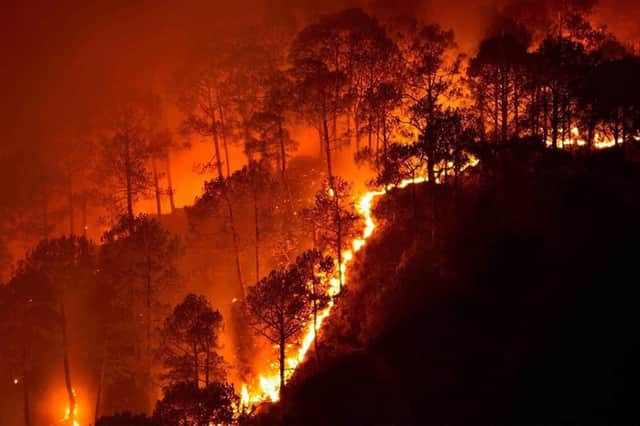Environment: It will only get worse with the amount of carbon dioxide in our atmosphere


The truth is a mixture of both. Extreme weather in Spain and North Africa has badly affected the crops so climate change is now impacting our food supply.
This will get worse as we continue to increase the amount of carbon dioxide in our atmosphere.
Advertisement
Hide AdAdvertisement
Hide AdWe are currently at 1.2C degrees of warming, but it is rising fast and so are the extreme weather occurrences that destroy crops all over the world. If you like to eat it is time to get serious about the climate emergency.
Comments on The Star letters page often accept climate change is happening, but then say there is nothing we can do about it as it is caused by “natural cycles”.
I want to explode that myth because unless we realise that our pollution is destroying the systems we need for survival, there is no hope for our future.
Carbon is the fourth most abundant element in the Universe. Most of Earth’s carbon—about 65,500 billion metric tons—is stored in rocks. The rest is in the ocean, atmosphere, plants, soil, and fossil fuels.
Advertisement
Hide AdAdvertisement
Hide AdYou probably learnt about the carbon cycle at school. Humans and animals breathe in oxygen and breathe out carbon dioxide.
Plants and plankton absorb carbon dioxide and release oxygen in the process of photosynthesis.
When plants are eaten, or they decay or are burnt, the carbon dioxide is released again. Sometimes the carbon is absorbed into rocks and over massive periods can become coal or oil.
Geochemists have found that every mass extinction event in the Earth’s history is linked to a massive disruption of the Carbon Cycle.
Advertisement
Hide AdAdvertisement
Hide Ad252 million years ago volcanoes were burning through carbon-rich limestone and igniting massive coal and natural gas deposits, injecting thousands of gigatonnes of CO2 into the air.
What happened? Mass extinction because the climate overheated.It is Carbon that modulates the temperature of the planet and the chemistry of the ocean. If the carbon cycle goes wrong, the thermostat breaks and the oceans acidify.
Peter Brannen writes in Greta Thunberg’s The Climate Book: “In the End-Permian mass extinction carbon dioxide blasted out of Siberian volcanoes for thousands of years and nearly ended the project of complex life.
All the normal guardrails in the carbon cycle buckled and failed in this, the single worst moment in the entire geological record.
Advertisement
Hide AdAdvertisement
Hide AdThe temperatures soared by 10C, the planet convulsed with lurid blooms of algal slime that robbed their ancient waters of oxygen.
This anoxic ocean instead filled with poisonous hydrogen sulphide as hurricanes roared overhead….one could travel the world without seeing a tree, the world’s coral reefs had been replaced by bacterial slime, the fossil records went silent and the planet took 10 million years to pull itself back from oblivion..”
What is happening today? We are igniting similar massive reservoirs of underground carbon by burning fossil fuels.
It’s not erupting through massive volcanoes; instead, we are mining and drilling to power our factories, cars, lorries, ships, planes, boilers, TVs, fridges, and game consoles.
Advertisement
Hide AdAdvertisement
Hide AdWe are emitting carbon at a rate ten times greater than previous mass extinctions.
The planet doesn’t care if this increase in carbon in the atmosphere comes from a once in a 100 million year volcanic event or a materialistic fossil fuel-burning industrial society. It will react in exactly the same way.
One worrying disruption to the carbon cycle is the growth of wildfires. A forest fire releases vast quantities of carbon into the atmosphere but also the destroyed vegetation ceases to absorb CO2 from the atmosphere.
Wildfires generate air pollution, destroy habitats and wildlife and damage water quality.
Advertisement
Hide AdAdvertisement
Hide AdThe Amazon basin used to be a huge carbon sink, so it absorbed massive amounts of carbon dioxide.
But now it is drying out due to climate change, making wildfires more likely and it is being felled to support industrial-scale agriculture. It has become a net source of carbon in the atmosphere.
The soil contains over 3000 gigatonnes of carbon, about four times the amount of carbon in the atmosphere and all the plants in the world combined.
It helps regulate the carbon cycle and contributes to food production, biodiversity, drought and flood resilience. But it is threatened by climate change.
Advertisement
Hide AdAdvertisement
Hide AdAs temperatures rise, the activity of microorganisms in the soil increases, so more CO2 is emitted. There is a danger of a terrible feedback loop, where increased temperatures increase soil CO2 emissions, which further increase temperatures.
To avoid this tipping point we need to take immediate action. We have to urgently reduce our CO2 emissions, plant far more trees and adopt sustainable agricultural practices.
This will increase the soil carbon bank and draw down atmospheric CO2. It isn’t just a lack of tomatoes we need to worry about. All life is threatened if we don’t stop disrupting the carbon cycle.
The climate has varied throughout the earth's history. Each time there has been a dramatic change it has been because the carbon cycle has been disrupted. Today the carbon cycle is being disrupted again.